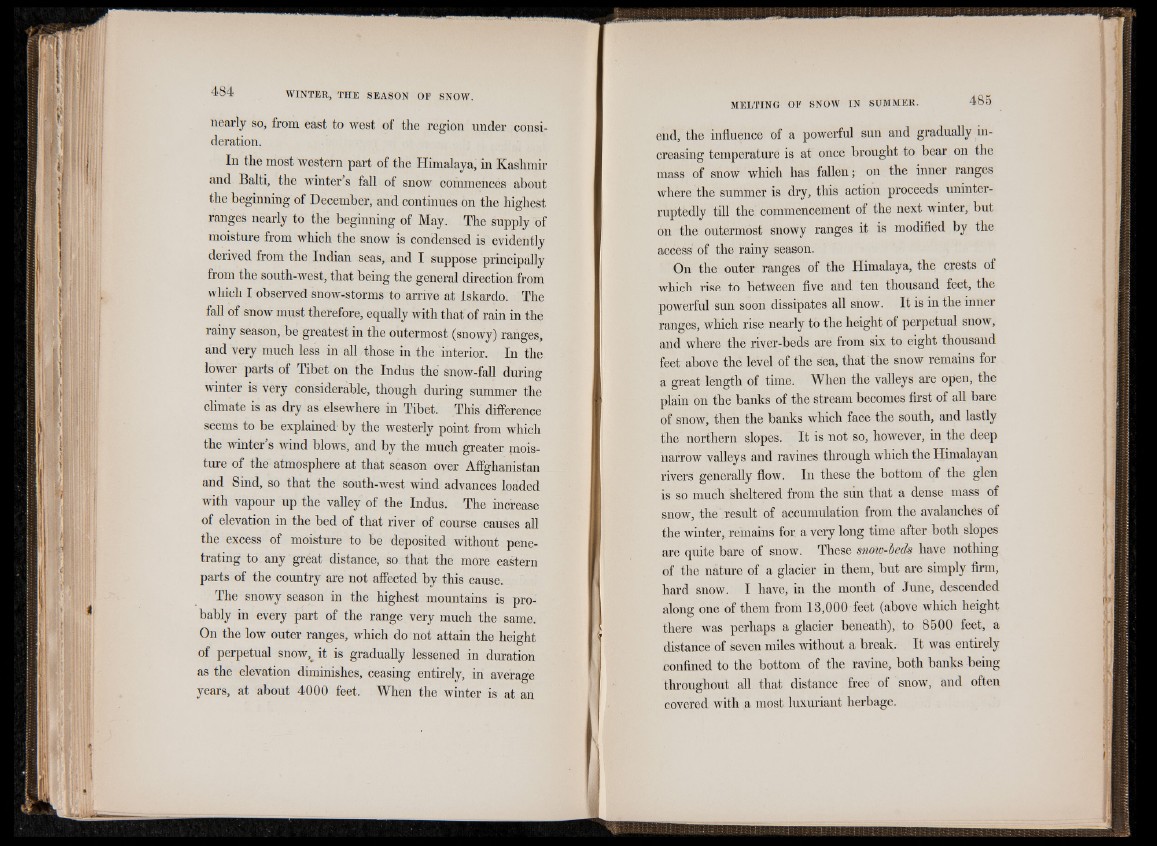
nearly so, from east to west of the region under consideration.
In the most western part of the Himalaya, in Kashmir
and Balti, the winter’s fall of snow commences about
the beginning of December, and continues on the highest
ranges nearly to the beginning of May. The supply of
moisture from which the snow is condensed is evidently
derived from the Indian seas, and I suppose principally
from the south-west, that being the general direction from
which I observed snow-storms to arrive at Iskardo. The
fall of snow must therefore, equally with that of rain in the
rainy season, be greatest in the outermost (snowy) ranges,
and very much less in all those in the interior. In the
lower parts of Tibet on the Indus the snow-fall during
winter is very considerable, though during summer the
climate is as dry as elsewhere in Tibet. This difference
seems to be explained by the westerly point from which
the winter’s wind blows, and by the much greater moisture
of the atmosphere at that season over Afghanistan
and Sind, so that the south-west wind advances loaded
with vapour up the valley of the Indus. The increase
of elevation in the bed of that river of course causes all
the excess of moisture to be deposited without penetrating
to any great distance, so that the more eastern
parts of the country are not affected by this cause.
The snowy season in the highest mountains is probably
in every part of the range very much the same.
On the low outer ranges, which do not attain the height
of perpetual snowv it is gradually lessened in duration
as the elevation diminishes, ceasing entirely, in average
years, at about 4000 feet. When the winter is at an
end, the influence of a powerful sun and gradually increasing
temperature is at once brought to bear on the
mass of snow which has fallen; on the inner ranges
where the summer is dry, this action proceeds uninterruptedly
till the commencement of the next winter, but
on the outermost snowy ranges it is modified by the
access of the rainy season.
On the outer ranges of the Himalaya, the crests of
which rise to between five and ten thousand feet, the
powerful sun soon dissipates all snow. It is in the inner
ranges, which rise nearly to the height of perpetual snow,
and where the river-beds are from six to eight thousand
feet above the level of the sea, that the snow remains for
a great length of time. When the valleys are open, the
plain on the banks of the stream becomes first of all bare
of snow, then the banks which face the south, and lastly
the northern slopes. It is not so, however, in the deep
narrow valleys and ravines through which the Himalayan
rivers generally flow. In these the bottom of the glen
is so much sheltered from the sun that a dense mass of
snow, the result of accumulation from the avalanches of
the winter, remains for a very long time after both slopes
are quite bare of snow. These snow-beds have nothing
of the nature of a glacier in them, but are simply firm,
hard snow. I have, in the month of June, descended
along one of them from 13,000 feet (above which height
there was perhaps a glacier beneath), to 8500 feet, a
distance of seven miles without a break. It was entirely
confined to the bottom of the ravine, both banks being
throughout all that distance free of snow, and often
covered with a most luxuriant herbage.